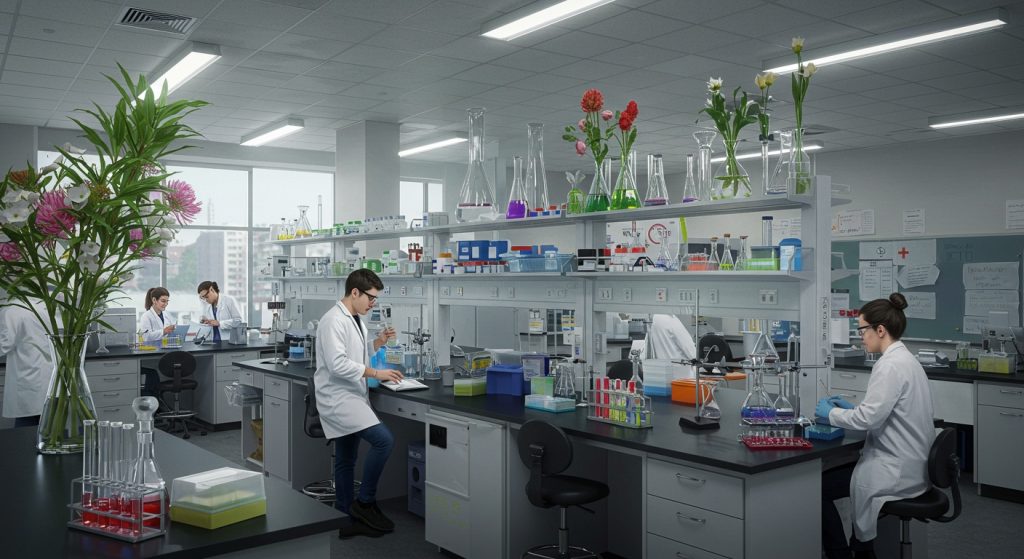Imagine a world where CRISPR gene editing technology, born in university labs, rapidly translates into targeted cancer therapies thanks to strategic partnerships with biotech giants like Amgen. This isn’t science fiction; it’s the escalating reality of university-industry collaborations. The convergence of academic discovery and industrial scalability is reshaping biotechnology innovation. From AI-driven drug discovery platforms co-developed by NVIDIA and leading research institutions, to synthetic biology ventures fueled by venture capital arms of major pharmaceutical companies, collaborative ecosystems are accelerating the pace of translating groundbreaking research into tangible healthcare solutions. Navigating the complexities of intellectual property, funding models. Differing research timelines is paramount to unlocking the full potential of these powerful alliances and driving the next wave of biotech breakthroughs.

Unlocking Innovation: The Power of Shared Resources and Expertise
University-industry collaborations represent a powerful engine for driving innovation, particularly in a rapidly evolving field like biotechnology. These partnerships leverage the distinct strengths of both academic institutions and private companies, fostering an environment where groundbreaking discoveries can translate into real-world applications. By pooling resources, sharing expertise. Aligning research goals, these collaborations accelerate the pace of scientific advancement and address critical societal needs.
Why Universities? The Academic Advantage
Universities are the wellspring of fundamental research, characterized by a spirit of inquiry and a commitment to pushing the boundaries of knowledge. They offer several key advantages in collaborative endeavors:
- Cutting-Edge Research: Universities are home to leading researchers and state-of-the-art facilities, driving innovation across various biotechnology disciplines, from genomics and proteomics to synthetic biology and biomanufacturing.
- Skilled Talent Pool: Universities educate and train the next generation of scientists, engineers. Entrepreneurs, providing a pipeline of highly skilled individuals for industry.
- Objectivity and Openness: Academic research is typically driven by scientific curiosity and a commitment to public dissemination of findings, ensuring transparency and fostering trust.
- Long-Term Perspective: Universities often pursue long-term research projects with potentially transformative impact, even if the immediate commercial applications are not apparent.
Why Industry? The Commercialization Catalyst
Industry partners bring crucial capabilities to the table that are essential for translating academic discoveries into marketable products and services:
- Product Development Expertise: Companies possess the know-how and resources to develop, manufacture. Commercialize innovative technologies.
- Market Knowledge: Industry partners interpret market needs, regulatory requirements. Competitive landscapes, ensuring that research efforts are aligned with real-world demands.
- Financial Resources: Companies provide the financial investment necessary to support research and development, clinical trials. Market launch.
- Scale-Up Capabilities: Industry has the infrastructure and expertise to scale up production processes, ensuring that innovative technologies can be manufactured efficiently and cost-effectively.
Key Elements of Successful Collaborations
While the potential benefits of university-industry collaborations are significant, successful partnerships require careful planning, clear communication. A shared commitment to achieving common goals. Key elements include:
- Clearly Defined Objectives: Establishing clear, measurable, achievable, relevant. Time-bound (SMART) objectives is crucial for aligning expectations and tracking progress.
- Intellectual Property (IP) Agreements: Negotiating fair and transparent IP agreements that protect the interests of both parties is essential for fostering trust and incentivizing innovation. These agreements must address ownership, licensing. Commercialization rights.
- Communication and Trust: Open and frequent communication is vital for building trust and fostering a collaborative environment. Regular meetings, shared data. Transparent decision-making are crucial.
- Project Management: Effective project management ensures that research efforts are focused, resources are utilized efficiently. Timelines are met.
- Mutual Benefit: Successful collaborations are mutually beneficial, providing universities with funding, access to industry expertise. Opportunities for technology transfer, while providing companies with access to cutting-edge research, skilled talent. Innovative technologies.
Examples of University-Industry Collaboration Models
Several models facilitate university-industry collaborations, each with its own strengths and weaknesses:
- Sponsored Research Agreements: Companies fund specific research projects at universities, providing researchers with resources and access to industry expertise.
- Licensing Agreements: Universities license their patented technologies to companies for commercial development.
- Joint Ventures: Universities and companies form joint ventures to develop and commercialize specific technologies.
- Research Consortia: Groups of universities and companies collaborate on pre-competitive research, sharing resources and expertise to address common challenges.
- Entrepreneurial Ecosystems: Universities foster entrepreneurial ecosystems by providing resources and support for faculty and students to launch their own companies based on university research.
Real-World Impact: Biotechnology Success Stories
Numerous groundbreaking biotechnology innovations have emerged from university-industry collaborations, demonstrating the transformative potential of these partnerships. Here are a few examples:
- Development of New Therapies: Collaborations have led to the development of novel therapies for diseases such as cancer, HIV/AIDS. Alzheimer’s disease. For instance, the development of checkpoint inhibitors, a revolutionary approach to cancer immunotherapy, stemmed from fundamental research conducted at universities and subsequently commercialized by pharmaceutical companies.
- Advancements in Diagnostics: Partnerships have resulted in the creation of advanced diagnostic tools for early detection and monitoring of diseases. Examples include rapid diagnostic tests for infectious diseases and personalized medicine approaches based on genomic profiling.
- Sustainable Biomanufacturing: Collaborations are driving innovation in sustainable biomanufacturing processes, enabling the production of biofuels, bioplastics. Other bio-based products. These partnerships are addressing critical challenges related to climate change and resource scarcity.
Challenges and Considerations
Despite the numerous benefits, university-industry collaborations also face several challenges:
- Conflicting Priorities: Universities prioritize academic freedom and public dissemination of research findings, while companies prioritize commercial interests and proprietary data. Balancing these conflicting priorities requires careful negotiation and clear communication.
- Cultural Differences: Academic and industry cultures differ significantly in terms of pace, decision-making processes. Reward systems. Bridging these cultural gaps requires building trust and fostering mutual understanding.
- Regulatory Hurdles: Navigating complex regulatory requirements for drug development, medical devices. Other biotechnology products can be challenging. Collaborations require expertise in regulatory affairs and compliance.
- Funding Constraints: Securing funding for collaborative research projects can be competitive. Partnerships require a compelling value proposition and a clear strategy for attracting investment.
The Future of University-Industry Partnerships in Biotechnology
The future of biotechnology innovation hinges on strengthening university-industry partnerships. As scientific knowledge expands and technological capabilities advance, collaboration will become even more critical for translating discoveries into real-world solutions. Key trends shaping the future of these partnerships include:
- Increased Focus on Translational Research: Greater emphasis on translating basic research findings into clinical applications and commercial products.
- Data-Driven Discovery: Leveraging big data, artificial intelligence. Machine learning to accelerate drug discovery and development.
- Personalized Medicine: Tailoring treatments to individual patients based on their genetic makeup and other factors.
- Sustainable Biotechnology: Developing environmentally friendly biomanufacturing processes and bio-based products.
- Global Collaboration: Expanding partnerships across national borders to leverage global expertise and resources.
Overcoming the Valley of Death: Bridging the Gap Between Research and Commercialization
A significant challenge in biotechnology innovation is the “valley of death,” the gap between promising research findings and commercially viable products. Many promising discoveries fail to make it through this valley due to lack of funding, expertise. Infrastructure. University-industry collaborations play a crucial role in bridging this gap by providing the resources and expertise needed to translate research into marketable products. For example, a university might discover a novel drug target. A pharmaceutical company is needed to develop and test a drug that hits that target. This requires significant investment and expertise that is usually not available in a university setting.
The Role of Government and Policy
Government policies and funding programs play a vital role in fostering university-industry collaborations. Policies that incentivize collaboration, such as tax credits for companies that invest in university research, can help to stimulate innovation. Government funding programs that support translational research and technology transfer can also help to bridge the valley of death. The Small Business Innovation Research (SBIR) and Small Business Technology Transfer (STTR) programs in the United States are examples of government initiatives that support university-industry partnerships and help to commercialize innovative technologies.
Conclusion
University-industry collaborations are undeniably powerful engines driving biotechnology innovation. Their success hinges on proactive engagement and a shared vision. Don’t wait for opportunities to fall into your lap. As demonstrated by the CRISPR-Cas9 breakthroughs originating from university labs and then rapidly commercialized, the most impactful collaborations often stem from identifying unmet industry needs and proactively proposing research solutions. My personal tip? Network relentlessly at industry conferences like BIO, not just to collect business cards. To genuinely comprehend the challenges companies face. Look beyond immediate funding opportunities; consider the long-term impact of your research and how it can translate into tangible products or services. Remember, the best partnerships are built on mutual trust and a commitment to shared success. So, embrace collaboration, be bold in your pursuits. Contribute to a future where biotechnology solves some of humanity’s greatest challenges. Let’s innovate together! For more insights on fostering successful collaborations, explore resources like the National Academies of Sciences, Engineering. Medicine reports.
More Articles
Unlocking Data Science: University Research Opportunities For Ambitious Students
Engineering Degree Job Placement: Where Graduates Find Success After College?
Top Engineering Schools Excelling in Robotics Research Around the Globe
Crafting Compelling Statements: How to Make Your Application Truly Stand Out
FAQs
So, what exactly are University-Industry Collaborations in biotech?
Think of it like this: universities are research powerhouses brimming with bright minds and groundbreaking discoveries, while industries have the resources and know-how to turn those discoveries into real-world products and solutions. University-Industry Collaborations (UIC) are simply partnerships where they team up! They combine their strengths to accelerate biotech innovation.
Okay, makes sense. But why bother? What’s in it for both sides?
Great question! Universities get funding, access to industry expertise. A clearer path to see their research make a tangible impact. Industries get access to cutting-edge research, talented students and faculty. A competitive edge by staying ahead of the curve. It’s a win-win, really!
What kinds of projects do these collaborations usually involve? Is it all lab coats and test tubes?
While lab work is a big part, it’s much broader than that! Think joint research projects, sponsored research agreements, licensing agreements (where a company gets the rights to use a university’s technology), student internships. Even faculty consulting gigs. It’s about getting the right people and resources together to tackle specific biotech challenges.
What are some potential downsides or challenges to these partnerships? It can’t all be sunshine and roses, right?
You’re right, there are hurdles. Things like intellectual property ownership (who owns the inventions?) , publication rights (when and how research results can be shared). Potential conflicts of interest (especially for researchers with ties to both university and industry) need careful consideration and clear agreements.
How do these collaborations actually drive innovation in biotechnology?
Essentially, they speed things up! By combining academic research with industry’s development and commercialization expertise, UICs can translate basic scientific discoveries into new drugs, diagnostics, therapies. Agricultural solutions much faster than either party could alone. Plus, they foster a culture of innovation by exposing researchers to real-world problems and market needs.
Are there any cool, real-world examples of successful University-Industry Collaborations in biotech that I should know about?
Absolutely! Look at the development of many groundbreaking cancer therapies. Often, the initial research is done at a university, then a pharmaceutical company steps in to develop, test. Bring the drug to market. These kind of collaborations are behind a lot of the medical advancements we see!
If I’m a student or researcher interested in getting involved, where do I even start?
Start by checking out your university’s technology transfer office – they’re the go-to resource for connecting with industry partners. Attend industry events, network with professionals in your field. Don’t be afraid to reach out to companies directly with your research ideas. Internships are also a fantastic way to get your foot in the door!



